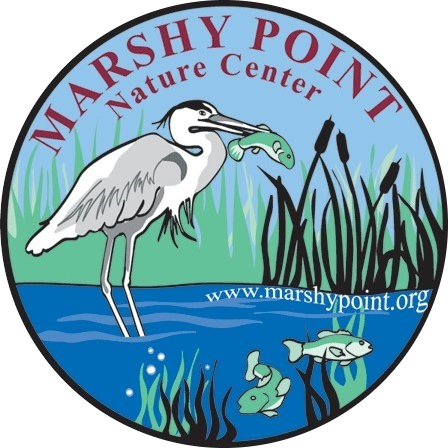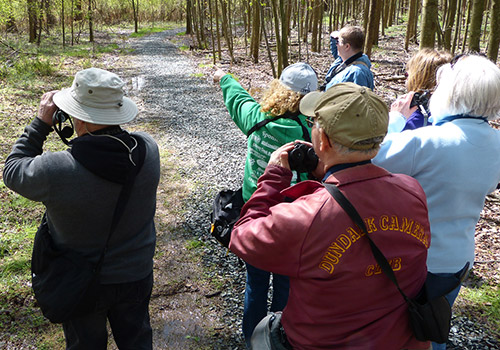
Below you can information about the wonderful mammals, reptiles, and birds of Marshy Point. Click on the category you would like to view to expand the selection. You can click on the category box again to close the selection.
(You can also check out Naturalist’s Notes, where our staff talk about seasonal and wildlife happenings around Marshy Point.)
[accordiongroup]Red Fox
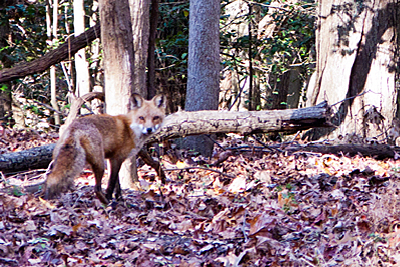
This red fox was photographed on 11/5/2011 near the intersection of the Weiskittel trail and the road.
The red fox is the largest member of the fox family, vulpes. Their length is 30 to 55”, 40% of which is the tail. They stand 14-20” high at the shoulder and weigh in at 7 to 24 lbs. Their range is North America, Europe, Asia, and parts of Africa. In Maryland, they are the more common than Maryland’s other fox species, the grey fox. The red fox typically has a white-tipped tail and black feet, while the grey fox may have a black-tipped tail and lack the black feet.
Red fox habitat is varied and they adapt well to human expansion. Maryland has much of their favorite habitats: open fields, small woodlots and wetlands.
Their diet consists of rodents, rabbits and birds, but may also eat fruit, vegetables, frogs and fish. They hunt alone and find their prey primarily by sound, but also with sight sensitive to movement. They leap on their prey from up to 5 meters away.
For more information on the red fox, please visit these web sites by clicking on their links:
Wikipedia – http://en.wikipedia.org/wiki/Red_fox
National Geographic – http://animals.nationalgeographic.com/animals/mammals/red-fox/
Maryland Department of Natural Resources – http://www.dnr.state.md.us/wildlife/Plants_Wildlife/animalbits/redfox.asp
Painted Turtle
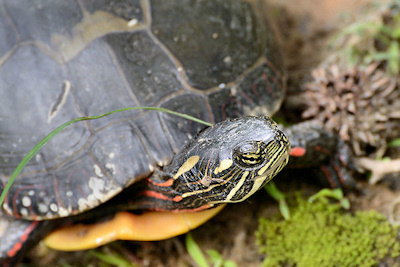

This female painted turtle (Chrysemys picta) had just finished laying eggs on the Greenway trail in mid-May. These turtles mate in spring and autumn and the female digs her nest on land/mud. In the wild they can live for more than 55 years.
The painted turtle has existed for about 15 million years, although the sub-species we see today evolved during the last ice age. They are active during daylight hours because they rely on warm conditions and can often be found sunning themselves for hours on rocks and logs. Their diet consists of aquatic vegetation, algae, insects, small fish and crustaceans. The adult turtle’s hard shell protects it from most predators, except alligators and raccoons.
The Eastern painted turtle is the sub-species seen here, and likes to live in freshwater ponds as well as marshes and brackish waters.
To learn more about painted turtles, please visit the following links:
Wikipedia – http://en.wikipedia.org/wiki/Painted_Turtle
Towson University – http://wwwnew.towson.edu/herpetology/reptiles/Chrysemys%20picta.htm
Snapping Turtle
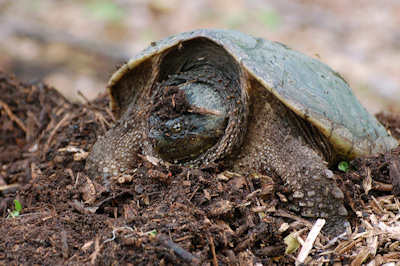
Photo courtesy of Bill Seigart
This common snapping turtle was seen on May 22, near the trail to Carol’s Glen. She had dug out an area in the top of a mulch pile and presumably had just laid eggs there. During nesting season, the female may travel a significant distance from water to find a suitable spot to lay her eggs.
Common snapping turtles usually live in shallow ponds, lakes, or streams, and sometimes in estuaries. They are omnivores, consuming both plant and animal matter, and are important aquatic scavengers; but they are also active hunters that prey on anything they can swallow, including invertebrates, fish, frogs, reptiles and small mammals. The young typically hatch between August and October. Snapping turtles spend the winter hibernating in the mud at the bottom of the pond/lake, etc. A common adult upper shell length is 8 to 18 inches and a common weight is 10 to 35 lbs.
Snapping turtles are dangerous due to the power of their jaws, their reach (to the hind legs) and their quickness. They should not be handled!
For more information, go to:
Wikipedia – Common Snapping Turtle: http://en.wikipedia.org/wiki/Common_snapping_turtle
Great Crested Flycatcher
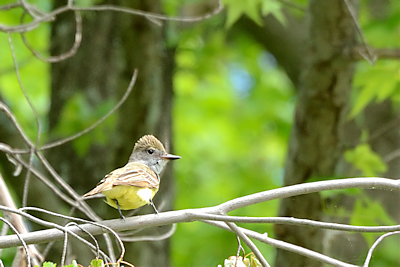
Photo courtesy of Werner Dirla
This photo was taken near the walkway to the Nature Center on May 20, 2012. The great crested flycatcher is usually found high in treetops and is therefore not easily spotted. They have a distinctive “whee-eep” call, and are more often heard than seen. They are fairly common in eastern and mid-western US states.
One of the more unusual “tidbits” of information about the great crested flycatcher is that many of their nests contain snakeskin. They live in deciduous woodlands and wooded swamps along with other areas. Their nests are typically found in the cavities of trees, but they will often use nest boxes too. Their diet consists mainly of insects, but will also eat fruit, berries and other invertebrates.
For more information on the great crested flycatcher, please visit these sites bly clicking their link:
Cornell Lab of Ornithology: http://www.allaboutbirds.org/guide/Great_Crested_Flycatcher/id
Wikipedia: http://en.wikipedia.org/wiki/Great_Crested_Flycatcher
Palm Warbler
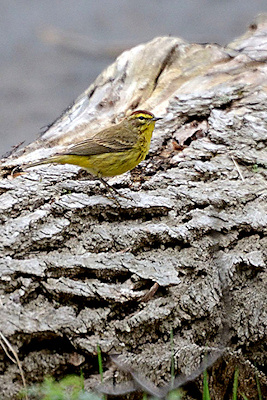
This photo of a palm warbler was taken in early April on the Greenway Trail near the lookout. Palm warblers are one of the earliest migrating warblers, arriving in our area in early April and can be found here until late May.
Palm warblers are 4.5 to 5.5 inches long, brownish above, yellowish below, but look for the distinctive chestnut-colored cap. Also, look for a constantly bobbing tail. This species can usually be found on or near the ground in brushy or wooded areas. They have a repetitive, weak, “buzzy” song. As with all warblers, they’re here for the insects. They do not nest here: in late spring, they’ll head for their breeding grounds in Maine and Canada.
For more information, go to:
All About Birds – Palm Warbler: http://www.allaboutbirds.org/guide/Palm_Warbler/id
Wikipedia – Palm Warbler: http://en.wikipedia.org/wiki/Palm_Warbler
Barred Owl
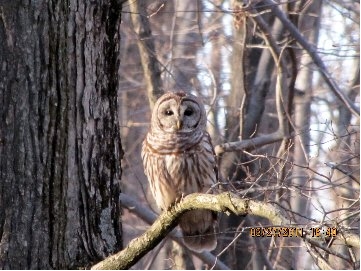
This barred owl was spotted in late March near the extremities of the park, on the marina side. They are large
owls that like woods that are wet and generally inhabit areas that are marshy. They will eat rodents and
other small mammals, but will also catch crayfish, frogs, snakes, lizards, small fish and bugs.
Their call sounds like “Who cooks for you? Who cooks for you all?” They sometimes sound like monkeys in the
woods and have been nicknamed monkey owls, hoot owls, and swamp owls. To hear their sound, click here
(http://www.allaboutbirds.org/guide/Barred_Owl/sounds), scroll down and click the “songs” player.
Barred Owls nest and raise their young in the early spring. The owlets can be found in tree cavities and their
parents will aggressively defend the site.
To read more about the barred owl, please visit these web sites by clicking the links below:
Cornell Lab of Ornithology – http://www.allaboutbirds.org/guide/Barred_Owl/id
Wikipedia – http://en.wikipedia.org/wiki/Barred_Owl
Hermit Thrush
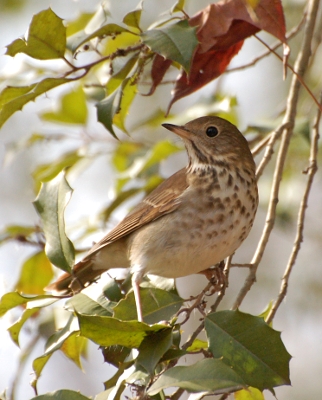
Photo courtesy of Bill Seigart
This hermit thrush is perched in an American Holly tree at Iron Point, a short walk from the Nature Center.
Hermit thrushes are a bit smaller than American robins, which are also in the thrush family.
The hermit thrush is the only member of its genus to winter in North America. It survives the northern winters
by introducing fruits into its normally insect-only diet. Feeding occurs mostly on the ground and in low bushes.
In spring they leave eastern Maryland and head north to their summer breeding grounds.
Many thrushes are wonderful songsters and the hermit thrush is no exception. It has a beautiful, flute-like song
that has been described as “ethereal”. Listen for its song in early spring. To hear the song of the hermit
thrush, click here, scroll down to “Sounds” and click the play button.
For more information on the hermit thrush, please visit these web sites by clicking below:
Cornell Lab of Ornithology – http://www.allaboutbirds.org/guide/Hermit_Thrush/id
Wikipedia – http://en.wikipedia.org/wiki/Hermit_Thrush
Bald Eagle
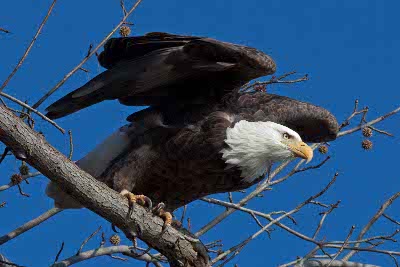
Photo courtesy of Joe Turner
This adult bald eagle was photographed at Marshy Point in early December 2010. Joe captured the eagle from the pier by the visitor’s center and timed the shot as it was about to launch from its perch.
Juvenile bald eagles are mostly brown in color and take 4 to 5 years to completely mature into the brown raptor with white head and tail that most of us recognize.
Bald eagles eat mainly fish, but will also eat muskrats, rabbits, turtles and other animals, including other birds. While they prefer fresh food, they will also eat carrion. They’ve also been known to occasionally steal a fish from a smaller osprey. When it comes to food, they are very opportunistic.
They are most often seen flying over bodies of water as they hunt, or perched in a tree near a source of food. They stay in our area year-round and may be joined in winter by eagles from farther north. Their wingspan is 6 to 7 ft, they weigh 10 to 14 lbs and they live for about 20 years.
They were almost eliminated from Maryland several decades ago. In 1977, there were only 44 breeding pairs in Maryland. The current number is believed to be around 500 pairs. Aside from the breeding programs, the two main reasons for the rebound are banning DDT and improving water quality.
For more information on the bald eagle, please visit these web sites by clicking on their link:
Cornell Lab of Ornithology – http://www.allaboutbirds.org/guide/Bald_Eagle/id
Wikipedia – http://en.wikipedia.org/wiki/Bald_eagle
Sharp-Shinned Hawk
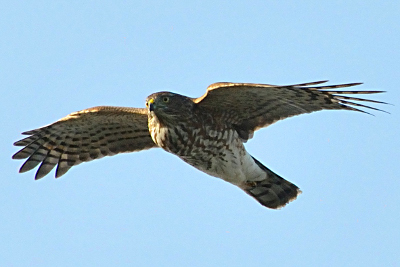
This sharp-shinned hawk was photographed at Iron Point in late October. “Sharpies,” as they are frequently called, are found in our area year-round, though they are more common here in the winter. It is the smallest hawk in the U.S. and is long-tailed with rounded wings, adapted for hunting birds among trees. They are also frequent visitors to bird feeders where they hunt for small songbirds.
Sharp-shinned hawks look very similar to the larger Cooper’s Hawk whose tail is more rounded at the tip. Note in the photograph that the tip of the tail is more squarish. Size can also be an indicator if you get a chance to see one near other birds: “Sharpies” are closer in size to a blue jay whereas Cooper’s are closer in size to a crow.
For more information on the sharp-shinned hawk, please visit these web sites by clicking on their link:
Cornell Lab of Ornithology – http://www.allaboutbirds.org/guide/Sharp-shinned_Hawk/id
Wikipedia – http://en.wikipedia.org/wiki/Sharp-shinned_hawk
Belted Kingfisher

This male belted kingfisher was seen in late October at Iron Point, just a short walk from the White Tail trail. These birds are found year-round near most open bodies of water, where they hunt primarily fish by plunging head first into the water. They can frequently be seen perched in a tree overhanging the water. They will also hunt amphibians, reptiles, insects, and small mammals.
The belted Kingfisher is 11-14” long, with a wingspan of 19-23”, and weighing 5-6 oz. This unusual species builds its nest in a cavity in a river or sandy bank, reached by a horizontal tunnel. Belted Kingfishers are also unusual due to the females being more colorful than the males, having a rufous band on the belly.
For more information on the belted kingfisher, please visit these web sites by clicking on their link:
Cornell Lab of Ornithology – http://www.allaboutbirds.org/guide/Belted_Kingfisher/id
Wikipedia – http://en.wikipedia.org/wiki/Belted_Kingfisher
Osprey
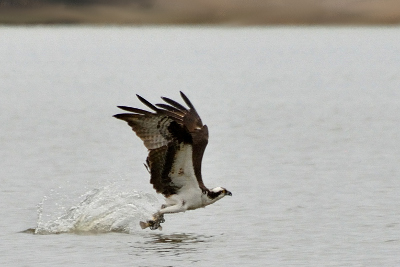
Osprey facts by Brent Byers
The osprey, a large bird with a wingspan of 4.5 to 6 feet weighs about four pounds. They have a dark brown back, a white belly, and a white head which features a dark stripe running from the eyes to the back of the head. Because of that white head they are sometimes confused with the larger bald eagle.
Unlike the bald eagle which stays in our area all year, osprey migrate. They arrive in our area in March and start the five month period of nesting and raising their young. Like bald eagles, osprey reuse old nests, adding new material to them each season. Osprey prefer to nest in trees near water or structures directly over water and eat mostly fish. Osprey three years or older usually mate for life. Around the end of April, the female will lay from 2 to 4 eggs, a few days apart. The eggs will hatch 4 or 5 weeks later in that same sequence. The female stays on the nest the majority of the time with the male supplying most of the food.
The excitement begins about eight weeks after hatching when the chicks begin to fledge. They call incessantly as they fly, and seem to be saying “Watch me, watch me!” or “Mom, I think I deserve a prize for flying”. They still use their nest for home base until they migrate which begins in late August for the adults. The newly fledged birds, however, linger a few weeks longer, a strategy which buys them additional time to improve fishing and flying techniques.
Even though fish may still be abundant in the bay, it is believed that the shorter length of day triggers the start of migration. Birds from the mid-Atlantic will arrive at their winter homes in Brazil by early November and by February will start heading north again.
For more information, please visit these web sites by clicking the links:
Cornell Lab of Ornithology – http://www.allaboutbirds.org/guide/Osprey/id
Wikipedia – http://en.wikipedia.org/wiki/Osprey
Blue Heron
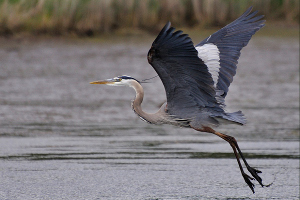
A blue heron takes off from the creek at Marshy Point, not far from the boat pier. Because of strong winds on the day this was taken, much of the water had left the creek and made fishing quite a bit easier for birds of all varieties.
The great blue heron can be found near wetlands in North and Central America. It has a wing span ranging from 5.5–6.5 ft. and weighs approximately 4.5–8 lbs. The heron’s main food source is fish, but it will also feed on shrimp, crabs, small rodents, and insects. It makes a deep croaking sound during breeding season or when disturbed.
For more information on the great blue heron, please visit these web sites by clicking on their link:
Wikipedia – http://en.wikipedia.org/wiki/Great_Blue_Heron
Injured Wildlife: Frequently Asked Questions
If you found a wild animal that appears to be in need of help:
Please do not kidnap a healthy wild animal. Use the following information to help you determine if the animal is really in trouble. In some cases, baby animals may appear to be alone and orphaned but the mother is really just hidden out of sight.
If an animal is obviously in need of help and shows signs of a problem—such birds entangled in fishing line, baby birds on the ground, a bird that has hit a window, a fawn that seems malnourished, a bat on the ground, or some other problem—please consult the information below or call one of the suggested wildlife phone numbers.
Important safety information:
Only adults should ever handle a wild animal, and should be extremely cautious when rescuing wildlife. If you have consulted with a wildlife expert and determined that an animal needs help:
- Please wear gloves and use a blanket or towel to catch the animal.
- Gently place the animal into a cardboard box or paper bag. Be careful! A wild animal that is hurt or frightened could bite or scratch.
- Some animals should not be handled by people without proper training.
Important wildlife phone numbers:
- Marshy Point Nature Center: 410-887-2817
- Maryland Department of Natural Resources, Scales and Tales: 410-461-5005
- Phoenix Wildlife Center: 410-628-9736
General Guidelines:
- Animals awaiting transport to a wildlife expert should be kept warm, safely contained, and away from loud noises, children, pets, and air conditioning.
- DO NOT FEED THE ANIMAL FOOD, WATER, OR MILK until you have spoken with a permitted wildlife rehabilitator. Water can go into the animal’s lungs and cause pneumonia. Feeding an animal the wrong food will cause more harm than good.
- Most native wildlife are protected by state and federal laws. It is illegal to possess the animal or its nests, bones, feathers, or eggs without the proper permits. Wild animals belong in the wild and are not pets.
Adult Animal Guidelines:
- Bats: Bats are no more likely to carry rabies than most other mammals but should be handled cautiously to avoid being bitten. If you find a bat in your house, use thick gloves or oven mitts to move it to an outdoor location. Bats require a drop from height to be able to take off and should be placed on a balcony or on a tree at least six feet off the ground.
- Birds of Prey: Adult birds of prey should not be handled by anyone without proper training. Call a wildlife expert if you find an injured bird of prey.
- Shorebirds: Entanglement in fishing line is a common problem for many types of shorebirds. Please call a wildlife expert for shorebirds entangled in fishing line. Fishing line is very difficult to remove and, if done improperly, could result in additional injuries to the bird.
- Songbirds: When birds hit a window they often experience temporary blindness. If a bird has hit your window and is still alive, but does not fly away, place the bird in cardboard box lined with paper towels. Place the box in a dark, quiet location for an hour or two. Take the box outside and release the bird. If the bird flies away it is fine, if not it should be taken to a wildlife rehabilitator.
- Turtles: Like most other animals, turtles have a defined home range or territory. They should not be removed from their territory unless injured or in danger.
- Waterfowl: Please call a wildlife expert for injured adult waterfowl.
- Woodpeckers: Injured woodpeckers should be taken to a wildlife rehabilitator but should never be transported in a box with a towel. Their tongues and toes can become stuck in a towel and cause more injuries.
- Other Animals: Call a wildlife expert with questions about other injured adult animals.
Baby Animal Guidelines:
- Baby Birds of Prey: Consult with a wildlife expert as some birds of prey can be extremely protective of their nests. For baby birds of prey found on the ground, they should usually be placed in a wicker type basket attached as high as you can reach in the tree.
- Baby Deer (Fawns): If you find a fawn but don’t see a mother in the area, the baby is probably fine. Fawns depend on their camouflage and keep very still to avoid predators. When a doe leaves a fawn alone she is usually not far away and will return when she thinks it is safe to do so. Does have even been known to place their fawns under the dryer vents of houses and leave them there for extended periods of time. If you see a fawn in the same location for several days or if it appears to be malnourished, call a wildlife expert for additional help.
- Baby Rabbits: If you disturb a nest of baby rabbits, make a new indentation in the ground within five feet of the original nest and place the rabbits in it. A mother rabbit only cares for her young twice a day, at dawn and dusk to keep them hidden. Watch carefully from a distance early or late in the day to see if the mother returns.
- Baby Songbirds: If you can reach it, baby songbirds should be put back in the nest they fell out of. The myth that a mother bird will not return if a person has touched the babies is not true. Most birds have little or no sense of smell, and parental instincts are very strong. If you cannot reach the nest, use a basket (like the kind that strawberries come in), lined with paper towels, and attach it to the same tree as the original nest. Place the basket as high up as you can reach. Step away from the nest and wait for the mother to return.
- Baby Waterfowl: All the eggs from a duck nest of ducks usually hatch at about the same time. Occasionally, a few eggs hatch late and these ducklings are on their own. Lone ducklings have not had the benefit of their mother’s waterproofing oil and should not be placed in water. Call a wildlife rehabilitator for further information.
- Other Baby Animals: Please call a wildlife expert for more information.
